
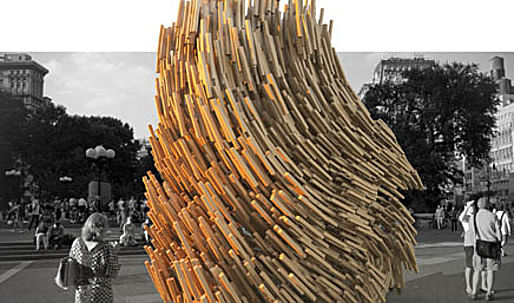
The shortlist of the Sukkah City Competition has just been announced, and in the next week, twelve structures will be built in Union Square Park in New York City, and subjected to a public vote. The competition invites architects to design a small structure based on the "parametric rules" of a traditional Jewish structure built for the harvest. Initiated by Joshua Foer, the competition is a daring initiative, particularly in a time when the locating of faith structures in New York City is under debate.
“Biblical in origin, the sukkah is an ephemeral, elemental shelter, erected for one week each fall, in which it is customary to share meals, entertain, sleep, and rejoice.
Ostensibly the sukkah's religious function is to commemorate the temporary structures that the Israelites dwelled in during their exodus from Egypt, but it is also about universal ideas of transience and permanence as expressed in architecture. The sukkah is a means of ceremonially practicing homelessness, while at the same time remaining deeply rooted. It calls on us to acknowledge the changing of the seasons, to reconnect with an agricultural past, and to take a moment to dwell on--and dwell in--impermanence.
Historically, the sukkah's permanent recurrence is not as a monument, archetype, or typology, but as a set of precise parameters. The basic constraints seem simple: the structure must be temporary, have at least two and a half walls, be big enough to contain a table, and have a roof made of shade-providing organic materials through which one can see the stars.
Yet a deep dialogue of historical texts intricately refines and interprets these constraints--arguing, for example, for a 27 x 27 x 38-inch minimum volume; for a maximum height of 30 feet; for walls that cannot sway more than one handbreadth; for a mineral and botanical menagerie of construction materials; and even, in one famous instance, whether it is kosher to adaptively reuse a recently deceased elephant as a wall. (It is.) The paradoxical effect of these constraints is to produce a building that is at once new and old, timely and timeless, mobile and stable, open and enclosed, homey and uncanny, comfortable and critical.” -- Sukkah City
I was personally interested in this competition because it coincides with one of my own projects, the build of The East London Sukkah , an interfaith collaboration between the anarchist Jewish collective Jewdas and The East London Mosque, and the arts catalyst Openvizor. While we will be exploring new materials and processes, and experimenting as designers, our interest was more in the process of tapping into local resources, building community partnerships, and utilizing it as a platform to bring together artists, thinkers, and activists to talk about food, faith and urbanism. The east end of London was once the centre of Jewish life in Britain, and it's now a great centre of Muslim life. Projects that connect the two communities, on a grassroots level, especially in innovative ways, are few and far between, so we thought to bring this harvest structure into public space in order to build something together, share meals from our allotment harvests under the stars, and find common ground to discuss strategies for sustainable food systems in London.
In a way, the "radical gesture" of The Sukkah City competition - to bring a traditionally private structure (built in backyards or synagagues) into public space, is neutralized in part because the structure is separated from its historical function as a place to share meals, sleep, eat, celebrate the harvest, and pray. In this competition, it will be exhibited as a sculpture, an architectural showcase, the biblical laws isolated as a set of building constraints. But I don't think this means it's an empty design exercise -- I can already see that that the premise alone of the competition has opened the eyes of the Jewish communities in London, who hadn't before considered the potential of the sukkah as a platform for design experimentation.
I found some of the entries beautiful and innovative, pushing the boundaries of traditional materials and building techniques. Gathering (top) has a dynamic motion that really speaks to the transience of structure, and Fractured Bubble, , a globe of native grasses, appears like a living creature offering shelter from the urban wilderness. But others, like Star Cocoon , appear so disconnected from the traditional language of the Sukkah that they appear to me like rehashed entries from a bus-shelter competition, modified slightly to fit the rabbinical rules.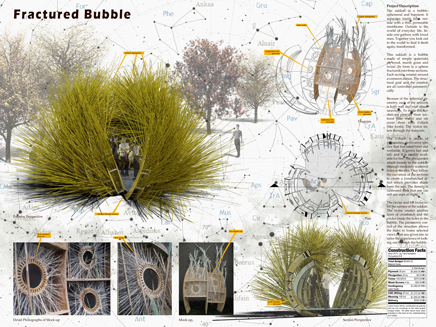
↑ Click image to enlarge
Fractured Bubble, by Henry Grosman and Babak Bryan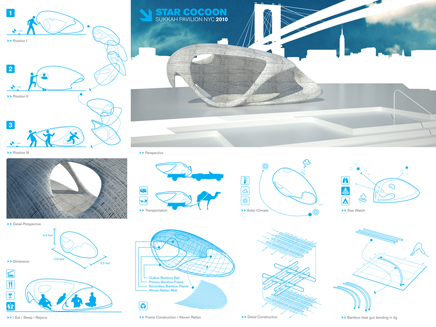
↑ Click image to enlarge
Star Cocoon by Volkan Alkanoglu
But it's up to the public to vote as the Sukkahs descend on Union Square. It would be great to hear what archinectors think (both of the shortlist, and the 600 entries posted online that didn't make the cut). Last week, Joshua Foer and I had a chat about the competition, and our discussion is below.
Could you tell me how this competition came about?
Last year my wife and I moved into a new apartment which had, for the first time, outdoor space. For some reason I got really into the idea of designing a sukkah for our deck. After all, what is a Jew if not an architect for one week each year? It was easy to get carried away. This humble little structures resonates in so many different dimensions. It's about reconnecting with an agricultural past, and contemplating ephemerality, and engaging in an act of communal memory, and even social justice (you can't eat and sleep in a sukkah for a week without thinking about others who never have a solid roof over their head). And then, you have to layer onto all that meaning and symbolism the sukkah's incredible esoteric rules, which grew out of what is probably the world's longest ongoing architectural conversation. This structure has been renewed for one week every fall for the last 3,000 years. Is there anything else in architecture that is so temporary and so permanent? As a design problem, it's just so rich. And yet somehow the sukkah has managed to fall off the radar screen of most American Jews. I thought: if we put this design challenge to the world's most talented architects, they will surely find interesting ways to respond to it. I brought the idea to my friend Roger Bennett, who has a reputation for being able to pull off crazy ideas like this, and together we worked to make it happen with the support of a wonderful organization called Reboot, the Union Square Partnership, and a host of other terrific partners.
What was the sukkah in your home growing up like?
Growing up, we would build a simple 2x4 sukkah whenever my dad would get off his tush and drag the lumber out of the garage--which was about every third year. Some of my fondest childhood memories are of having meals with my family beneath a leafy roof under the stars, just at that moment when summer is starting to become fall, and the air is getting crisp again.
What did it mean to move the sukkah into the public realm like this? How did the city register these faith structures in public space? As we sought a public site for our structure in London, we faced some fear, both of hate crimes and of casual teenage vandalism.
Like Christmas trees in December, the sukkah has long been a part of New York's seasonal landscape. Every fall, they pop up in parks around the city. They just tend to be pretty drab and forgettable. As for the squatters, vandals, and skinheads... Roger and I will be sleeping in the sukkahs every night with baseball bats to keep them out.
How are your sukkahs being used? Are they acting as follies in the landscape, or will people be eating, sleeping, and using them?
This is an architectural exhibition, an opportunity to showcase what the sukkah could be. It will be up for only two days, before the festival of Sukkot even begins. One structure will be voted on by New Yorkers to stand for the week-long holiday. Our objective is to demonstrate the range of possibilities inherent in this ancient typology. Our greatest hope is that this contest will have elevated the sukkah into a venue for architectural research. We want architects to see it as a once-a-year opportunity to try something experimental and temporary. In the years to come, we would like to see architect-designed sukkahs in cities all over the world. Next year Sukkah City goes global. We'll be helping to pair architects with communities around the world in search of architect-designed sukkahs. We've already been contacted by Melbourne, Baltimore, San Francisco, London, and Kinshasa. Actually, we haven't heard from Kinshasa... yet.
What makes a sukkah "radical" -- ? Is it in pushing the boundaries of form and materials, or is it in the building process, or about the public siting of the structures? Or is it what happens inside the structures, and how they facilitate interactions?
What makes the sukkah radical is the fact that it is at once entirely ephemeral and yet as permanent as anything in architecture. It exists for just a week, and yet it has existed for 3,000 years. So much of its meaning is wrapped up in the performance of assembling and disassembling it.
I'm also wondering about the "nomadic" aspect of the structures, did many design structures that could be deployed, folded away and brought out again in the next year? If not, what happens to the structures that don't win the public vote? Is there a strategy for those materials?
Some of the architects created nomadic structures, some built semi-permanent follies. A few of the non-winning structures will be transferred to other institutions around the city. In keeping with the spirit and themes of the sukkah, the rest will be auctioned off, with the proceeds going to Housing Works, a charity that provides for New York City's homeless population.
Is there some meaning behind the vernacular aesthetic of the sukkah? Is the traditional visual language important to their history?
As a vernacular structure, the sukkah has a fascinating history. The tradition of decorating the sukkah is recorded as early as the 8th century BC. Wherever the Jewish diaspora has gone, the sukkah has taken on local architectural flavors. In Kurdistan, sukkahs were traditionally built on roofs. In Bukhara, in present-day Uzbekistan, they're decorated with colorful silks. Among the wealthy Jews of Western Europe, it was common to find elaborate trompe l'oeil paintings of pastoral scenes on the insides of sukkahs. What is unique about the sukkah is that it has not been handed down over the centuries as an archetype or a kit of parts. There is no image of what a sukkah must look like. Rather, the structure has been transmitted as a set of parametric rules, open to interpretation.
Are all of these really following the rules? It's hard to see the three walls on many of these (though you can see in some of the entries, like p.yros.c. that they've diagrammed out the three walls). I'm also wondering about Single Thread -- which I think is lovely as a concept, but I thought you couldn't have steel on the roof? Isn't the roof supposed to be made of entirely natural materials?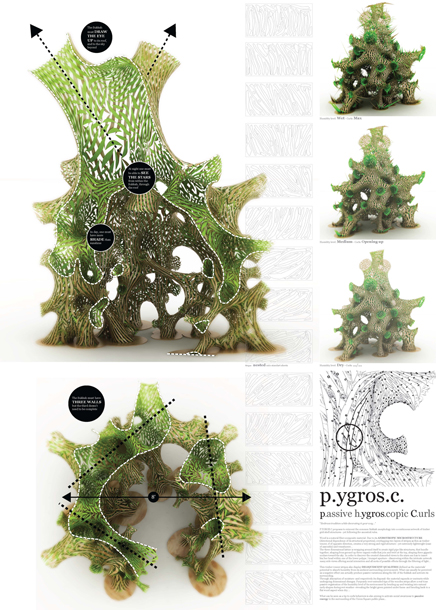
↑ Click image to enlarge
P.YGROS.C / passive hygroscopic curls by THEVERYMANY / Marc Fornes with Jared Laucks
↑ Click image to enlarge
Single Thread by Matter Practice
The rules are at the root of the competition. Without them, it's just a hut, not a sukkah. We had a rabbinic student and engineer (how often do those two titles overlap!) named Dani Passow, from Yeshivat Chovovei Torah, send back design notes to each of the architects. Several of the wining designs had to be tweaked in order to be made kosher. As you mention, the Talmudic rules of the sukkah call for a minimum of two and a half walls. In one case, one of the architects had to drop a couple threads of invisible fishing line to the ground from one of his walls in order to render it a proper "wall" according to Jewish law. Another law holds that the schach, the botanical materials that make up the overhead condition, cannot directly touch metal, or any other material that is man-made. One of the structures you mention--Single Thread--is constructed out of steel wire. The architects had ensure that their schach--dried flowers--was connected only indirectly to the steel, by way of an organic material.
Oh that's interesting -- so some of the entries that seemingly had the most simple and pure concept for their structures actually were the more complex or messy ones, to get through the legal loopholes. What about the LOG entry? That one made me smile.
I love LOG, too. Structurally, it's quite a challenge to pull off--a log on top of glass. It also turned out to be a challenge to make it a kosher sukkah. Because the laws of the sukkah require that the roof be porous to rain, they had to drill several holes through the log.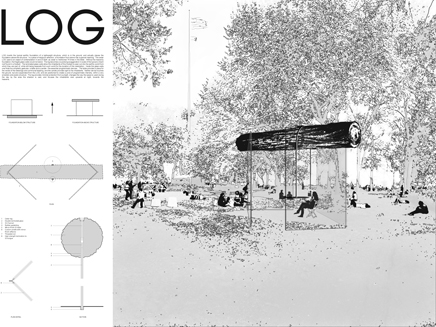
↑ Click image to enlarge
LOG by Kyle May and Scott Abrahams
The sukkah made of homeless signs is a strong concept, and it relates to the idea that a sukkah should be a structure "where the lord of the manor becomes closer to the man who sleeps on the park bench."
The architects--Ronald Rael and Virginia San Fratello--come from the Bay Area, where there is, unfortunately, an enormous homeless population. Part of the beauty of their design is that it directly transfers their prize money to those most in need. I can't think of anything more befitting the themes of the sukkah. All of our structures will ultimately be auctioned off, with the proceeds going to support Housing Works, a charity that provides services and housing to the homeless population in New York City.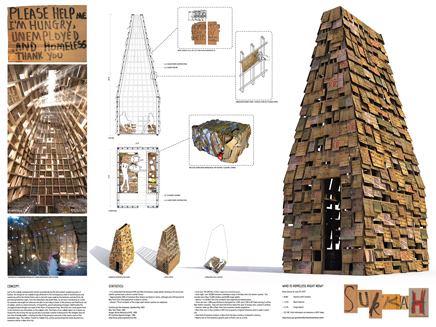
↑ Click image to enlarge
Sukkah of the Signs by Ronald Rael and Virginia San Fratello.
Do the designers have their own histories with sukkahs?
For most of the winners, this is their first sukkah. As it turns out, we have Muslim, Christian, and Jewish architects among our winners. We had entries from 43 countries, but our winners ended up coming from only three places: Germany, the US, and England. About half are based in the New York area.
How much time do they have to build the structures, and are they being built on site?
The structures are mostly being pre-fabricated off-site at the Gowanus Studio Space in Brooklyn. Because Union Square is one of the busiest places in New York City, they will have to be installed on site overnight, and fairly quickly.
Sukkahs are often a participatory or collective build -- I'm wondering whether these structures allow for the community to become part of the process of their making? It seems like this aspect of the sukkah could be written into the design itself -- how can children be engaged in decorating the sukkah beyond the paper chains most schools rely on?
The participatory element of constructing the sukkah is an essential part of its program. There's an old tradition that one should hammer the first nail into the sukkah immediately following the Yom Kippur break fast. The idea is to transition straight away from the most somber, self-reflective day of the year directly into what is traditionally considered the most joyous holiday on the Jewish calendar. It's a remarkable notion that an act of physical construction should mark that transition. In keeping with that tradition, Sukkah City will be installed in Union Square at midnight immediately following Yom Kippur.
Creative Commons License
This work is licensed under a Creative Commons License .
/Creative Commons License
5 Comments
very interesting initiative Joshua, and nice analysis and interview Heather.
i'm really digging Fractured Bubble, as well as the Sukkah of the Signs.
While I was an undergrad at UF, Professor Donna Cohen would have her 3rd yr Fall studio make Sukkahs. Each of the 12 or so students in her studio would make a proposal, and 3-4 of the designs would be selected, developed and ultimately built on campus, in various locations. One year a Jewish organization on campus held a "Sukkot Survivor" contest...people would spend the week living in the Sukkah's, only leaving for class.
see the photo of "gathering" here-
http://candydatec.xanga.com/photos/a6f44271970343/
i think it resembles its rendering most out of the 12 entries.
AP, do you have any pics of the sukkahs built and the survivor concept? That's brilliant.
Heather, I don't have any pics, but a good friend was one of the winners in 2003 (?), so I can ask her for pics of her Sukkah. On the Sukkot Survivor, I found this online:
http://www.alligator.org/news/campus/article_8117f207-465a-5111-99ed-8704c2d132fc.html (from 2009)
http://www.hillel.org/about/news/2001/20011004_sukkot.htm (from 2001)
now evidently the UVA Hillel group has a similar event:
http://www.virginia.edu/uvatoday/newsRelease.php?id=823
Very enjoyable article on a wonderful competition project. Really beautiful work.
Block this user
Are you sure you want to block this user and hide all related comments throughout the site?
Archinect
This is your first comment on Archinect. Your comment will be visible once approved.